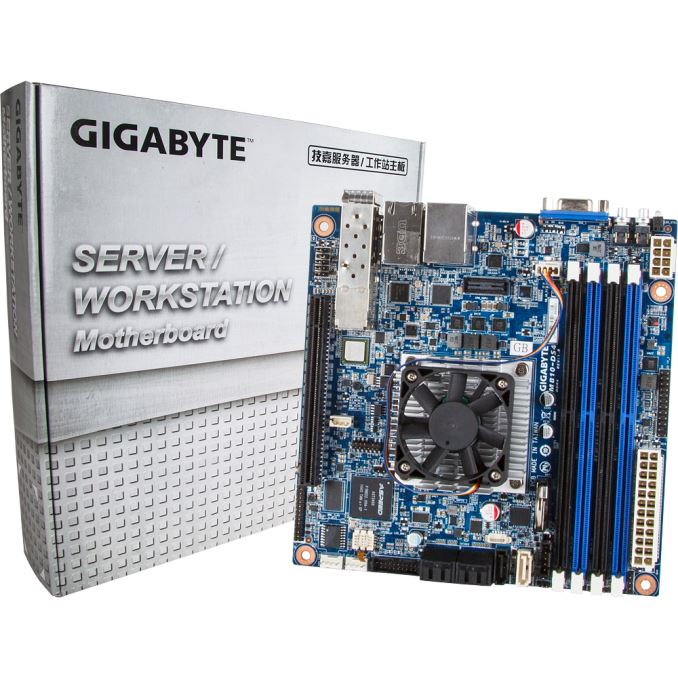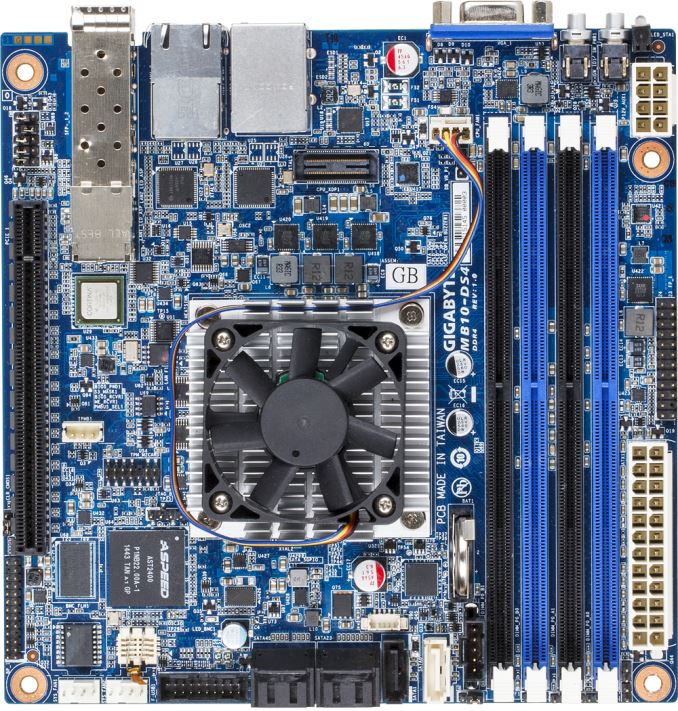New GIGABYTE Server Motherboards Show Xeon D Round 2
by Ian Cutress on January 18, 2016 8:00 AM EST- Posted in
- Motherboards
- Networking
- Gigabyte
- NAS
- Enterprise
- Servers
- Xeon-D
- Broadwell-DE
- SFP+

The Xeon D platform, as reviewed by Johan back in June, put together eight Broadwell cores, 24 PCIe 3.0 lanes, dual 10 Gbit Ethernet and USB/SATA control all into one SoC within a 45W TDP design. It almost sounded too good to be true (I’ve run some benchmarks my side, to be in a review later), as this is the only real way to get eight 14nm cores into a single die. Even at 2 GHz, Johan’s piece showed that the Xeon D based on Broadwell aims to fit between the Xeon E3 and Xeon E5 in terms of performance and power efficiency, and to quote Johan ‘Xeon D is probably the most awesome product Intel has delivered in years, even if it is slightly hidden away from the mainstream’. There is interest both server side and NAS side for this, and with the next wave of Xeon D parts being introduced GIGABYTE Server is one of the first to announce some new models.
Technically, the four motherboards being launched are a single base design, but with either a different SoC or different networking:
| 2 x 1 GbE + 2 x 10GbE SFP+ |
2 x 1 GbE Only |
|
| With Xeon D-1541 | MB10-DS3 | MB10-DS0 |
| With Xeon D-1521 | MB10-DS4 | MB10-DS1 |
The image above is the top end MB10-DS3 model, featuring the Xeon D-1541 processor with 8 cores, 16 threads, running at 2.1/2.7 GHz for base and turbo frequencies. This is a mini-ITX board aimed at the typical 1U chassis, with four RDIMM/UDIMM DDR4 slots for up to 128 GB RDIMM support in ECC or non-ECC fashion. As mentioned before, the differentiator on this model aside from the SoC is the networking, and here we get dual Intel I210-V gigabit Ethernet paired with dual Cortina CS4227 10GbE SFP+ LAN ports to either route teamed to an SFP+ switch or to different switches althogther.
The motherboard uses a single PCIe 3.0 x16 slot which can be used for compute, and storage comes via five SATA 6 Gbps ports and another similar port that also supports SATA DOM. With it being a server motherboard, the onboard Aspeed AST2400 provides an IPMI interface for management as well as a 2D acceleration video chip. There are two extra fan headers on board, as well as a USB 3.0 header and a TPM header.
The SoC here has a list price of $581 on its own, and given that this is a server part I’m not too sure we will see these set of boards actually up at retail, although I do know that GIGABYTE Server is trying to push more product through that distribution channel. Businesses interested in the platform will have to enquire to their local GIGABYTE office to find out more information on pricing and availability.
As part of the second wave of Xeon D processors, Intel seems to be releasing a number of 35W and 45W models, from four cores to eight cores (with Hyperthreading), varying otherwise by speed and last level cache in-line with core count. I imagine that as more of these trickle through into the hands of OEMs, we will see more products through 2016.
Table of Xeon-D processors from ServeTheHome













23 Comments
View All Comments
Dug - Tuesday, January 19, 2016 - link
I agree with needing a bit more.For 2016 I need to add a SAS adapter and RDMA nic for Storage Direct testing. So need two slots.
This easily can be done in 1U short depth rackmount.
No reason to go 2U because the storage will be jbod.
bill.rookard - Monday, January 18, 2016 - link
I wonder what kind of price range we might be looking at. Supermicro is running about $800+ for the 1541 8 core with similar specs. Of course, they're the only game in town at the moment if you want this type of setup, hopefully competition will bring the price down somewhat.I'd love to drop one of these in my webserver support server running a bunch of VMs and drives. Right now I have a Xeon X3450 and it's pretty efficient, but this would be a whole new level of power savings.
zepi - Monday, January 18, 2016 - link
As long as AMD is basically absent from the market, Intel will charge top dollars for their soc's driving up the pricing of the whole platform. Let's hope that AMD could come up with quad-ddr4 ZEN with 6-12 cores with remotely competitive perf/w / frequency / IPC combination.10101010 - Monday, January 18, 2016 - link
Street price is around $1000-$1100 for the dual 1G Ethernet model.ZeDestructor - Monday, January 18, 2016 - link
For those wondering, the CS4227 is just the SFP+ PHY. The controller/MAC is still Intel-based, with the PHY-controller link one over 10GBASE-KR.nils_ - Wednesday, January 20, 2016 - link
I was wondering about that. I think I've seen boards that actually use an Intel 10G chip instead of the SoC...ZeDestructor - Thursday, January 21, 2016 - link
Many list it as an Intel X552 (which is what you'll see in device manager/lspci).DanNeely - Monday, January 18, 2016 - link
Does using SATA DOM offer any advantages over SATA M.2, or is it just a legacy interface that's stuck around in the enterprise for some reason?ZeDestructor - Monday, January 18, 2016 - link
Mostly legacy that stuck around from enterprise never bothering with mSATATom Womack - Monday, January 18, 2016 - link
I'm a bit sad this list isn't showing the rumoured 12- and 16-core Xeon D devices.(I have returned my Xeon-D system for a refund and bought an i7-5820K with the money - for the kind of things I do I am not power-constrained and six fast cores are better than eight slow ones)